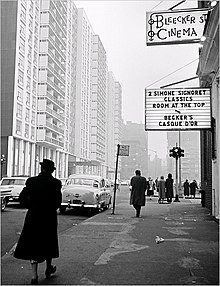Bleecker Street Cinema

Bleecker Street Cinema, looking east
|
|
| Location | 144 Bleecker Street Manhattan, New York City, New York |
|---|---|
| Owner | Lionel Rogosin |
| Type | Art house movie theatre |
| Opened | 1960 |
| Closed | 1991 |
The Bleecker Street Cinema was an art house movie theater located at 144 Bleecker Street in Manhattan, New York City, New York. It became a landmark of Greenwich Village and an influential venue for filmmakers and cinemaphiles through its screenings of foreign and independent films. It closed in 1990, reopened as a gay adult theater for a time afterward, then again briefly showed art films until closing for good in 1991.
The building at 144 Bleecker Street in New York City's Greenwich Village that would eventually house the Bleecker Street Cinema was originally built in 1832 as two rowhouses at 144 and 146 Bleecker Street. Placido Mori converted 144 into the restaurant Mori in 1883. As architecture historian Christopher Gray wrote,
At some point, [Placido] Mori befriended a novice architect, Raymond Hood, gave him a house tab and an apartment upstairs and in 1920 had him design a new facade for the building to include 146 Bleecker. Hood gave the buildings a row of Doric columns across the first floor, imitation Federal lintels over the windows and a setback penthouse studio.
Mori closed in 1937. The building remained unoccupied until 1944 when political and activist organizations including Free World House headquartered there for two years. Sometime afterward, the space became the Restaurant Montparnasse. By 1959, the building was owned by New York University.
Filmmaker and social activist Lionel Rogosin founded the 200-seat Bleecker Street Cinema in 1960 in order to exhibit his controversial 1959 film Come Back, Africa. In the early 1960s, the independent-filmmakers' group The Film-Makers' Cooperative, of which Rogosin was a supporter, showed experimental movies there as midnight screenings. Soon the venue became, in the words of film critic and historian James Hoberman, one of "three key revival houses: The New Yorker, the Bleecker Street [Cinema], and the Thalia", in New York City during the 1950s and 1960.
...
Wikipedia
